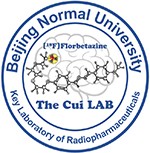This study reported the design, synthesis and bio-evaluation of 2-phenylbenzoheterocycles with chiral dihydroxyl side chains as β-amyloid (Aβ) imaging probes. This strategy of introducing two hydroxyls offered a simplified method for effectively reducing the lipophilicity. The probes (R, S)/(S, R)-14–15 with benzothiazole scaffold displayed good binding affinities toward Aβ1-42 aggregates with Ki values ranging from 47.63 to 56.28 nM. Further biological studies shown that (R, S)/(S, R)-[18F]14 have no obvious chirality-related discrepancy in binding ability and mice bio-distribution, while (S, R)-enantiomer exhibited slightly faster brain washout rate than (R, S)-enantiomer. Compared to the FDA approved [18F]Florbetapir and the fluoro-peglated 2-phenylbenzothiazole derivatives, (S, R)-[18F]14 displayed improved brain kinetics (6.40% ID/g at 2 min, brain2 min/brain60 min = 7.80) that is favorable for further application. In vitro autoradiography studies validated its high affinity and specificity to Aβ plaques. Overall, (S, R)-[18F]14 deserved further detailed study as a potential PET imaging probe for AD early diagnosis.

原文链接:https://www.sciencedirect.com/science/article/pii/S0968089620307148
